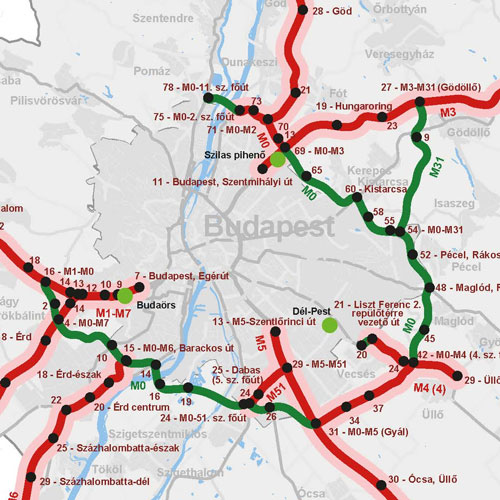Bad idea of the day: toll on M0, the ring road around Budapest
December 11, 2014
An article published yesterday in Népszabadság reveals that the Hungarian budget for 2015 includes a proposal to introduce tolls on several motorway segments that are toll-free today. To me, this sounds like a bad idea.
I do not want to go into too much detail here, those who are interested in road pricing in general can read the exceptional textbook, The Economics of Urban Transportation by Small and Verhoef, Small, K. A., Verhoef, E. T., & Lindsey, R. (2007). The economics of urban transportation. Routledge. a study, Road work: A new highway pricing and investment policy, by Small et al., Small, K. A., Winston, C., & Evans, C. A. (1991). Road work: A new highway pricing and investment policy. Brookings Institution Press. or a short article, Tengelyre, magyar! Hann, A. (2013). Tengelyre, magyar! – Az optimális útdíj kiszámítása. Magyar Narancs 2013/16 that I wrote (in Hungarian), but the general idea is that tolls should be set at a level so that the private cost of the trip equals the cost for the society. For example, drivers do not take into consideration that their trip will cause environmental damage, noise pollution, and further congestion even though these affect everybody. If there is a toll, drivers have to include it in their private cost-benefit calculation of undertaking a trip; the toll can be set at a level such that only those trips are made where the private benefit is higher the total cost of the society. However, these simple calculations only work when there is only one road. When there is a free alternative (rural roads), we have to take into account that if the price of the motorway is too high (it outweighs the personal benefits), people will switch to the free alternative.

When we look at cars (not trucks) and their choice of traveling on the motorway or rural main roads, it is clearly better for those who live in municipalities that lie on the rural roads if the cars choose the motorway: less noise, less traffic, fewer accidents. Drivers also save a significant amount of time and they also suffer fewer accidents. Albalate and Bel Albalate, D., & Bel, G. (2012). Motorways, tolls and road safety: evidence from Europe. SERIEs, 3(4), 457-473. , for example, analyze European panel data of countries and show that the number of accidents significantly decreases as the proportion of free motorways increases in a country; however, they find no effect for motorways that are tolled. When the motorway has already been built, the costs of cars using it are not too high, either: cars cause almost no wear and tear to the paving and while congestion may be an issue on highways, if they are not used, there will be congestion on the rural roads instead.

Final version of paid (red) vs. free (green) segments: most parts of the M0 ring road remain free as a condition of financing by EU structural funds. While there are junctions where you get on it via a city road, the highways leading to M0 are all paid. SourceMotorways and trunk roads around Budapest are currently free; most of these would be tolled accoding to the government’s plans except for a few segments on the southern part of the M0. Nándor Csepreghy, Deputy State Secretary for Development Policy Communication at the Prime Minister’s Office claims that the toll is so low (about €17 per year if the driver uses motorways only in Budapest and the surrounding Pest county) so no commuters will switch to smaller rural roads. However, this is not how price elasticity of demand works. There many trips, especially to hypermarkets, DIY stores, outlets, etc. which are just outside the city next to the motorways that are much less frequent so the relative increase in the price of the trip may be quite large – and can lead to more people choosing to stay off the motorway. The number of these drivers could be quite high, however, since cost-benefit analyses and feasibility studies are out of fashion in today’s Hungary, we do not know these numbers.
The case of the M0 is special of course due to its location, but if one looks at Hungarian motorways farther away from the capital, they tend to be quite empty – especially the M6 which does not reach the border. This may be a sign that road tolls are too high. I am skeptical about cars having to pay road tolls in general. I do not know of research on the topic, but I think it would be very interesting to see how making all motorways free in Hungary (instead of the government arbitrarily introducing or changing tolls) would affect the total benefits of the society. Since the motorways have already been built, their construction costs are sunk. While there would be a decrease in the income of the central budget, there would be practically no extra costs: more cars would hardly require more road maintenance. In the unlikely event of motorways becoming over-congested, I am not exaggerating, Hungarian motorways are rarely congested, except for the segments in the vicinity of Budapest and the M7 (which leads to lake Balaton) on summer weekends. people can still return to rural roads. On the positive side, instead of empty motorways, we would see villages relieved from the burden of high traffic, fewer accidents, and significant time savings. Monetary values can be assigned to all of these effects, so the benefits and the (minimal) costs of such a measure could be compared.
A previous version of this article originally appeared on transporteconomics.hu, a transportation-focused personal blog I do not update anymore.